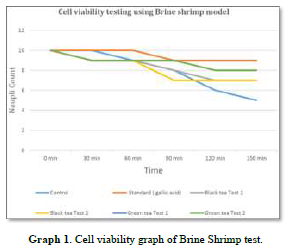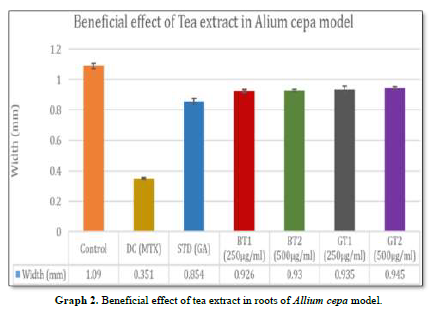82
Views & Citations10
Likes & Shares
Introduction: Cytoprotective agents are defined as the drugs that are given in combination with certain types of chemotherapy to protect the body from or decrease the adverse effect of chemotherapy. The leaves of the Camellia sinensis plant are used to make both green and black tea. The majority of polyphenols found in green tea, referred to as GTPs, are a type of flavanol known as catechins. Green and black tea flavonoids are known to protect your heart. Due to polyphenols, both Black tea and green tea have anti-inflammatory, anti-oxidant, cytoprotective action in cancer and advised for consumption of same.
Conclusion: Based on the results obtained in this study, it can be concluded that the aqueous extracts of black tea and green tea showed cytoprotective activity.
Keywords: Camellia sinensis, Cytoprotective Agents, Allium Cepa model, Brine Shrimp model
Cancer is a disorder characterized by an abnormal growth of cells, primarily caused by changes in DNA. These genetic alterations can result from various factors, such as errors during cell division, exposure to harmful environmental substances like tobacco smoke and UV rays, or even genetic inheritance [2]. Recognizing the signs and symptoms of cancer, such as breast changes, bladder problems, fatigue, neurological issues, skin changes, hoarseness, or unexplained fevers, is crucial for early detection.
The etiological factors contributing to cancer are varied, including alcohol, tobacco consumption, physical inactivity and unhealthy diet, and exposure to air pollution. In 2020, Cancer is a significant problem worldwide, with 19.3 million new cases and 10 million deaths reported. [3]. Medications like Doxorubicin are employed in cancer treatment, both in combination with other drugs and on their own, addressing a range of cancer types [4]. However, despite advancements in cancer treatment, side effects remain a concern, including pain, fatigue, anemia, mouth issues, nausea, weight changes, dietary problems, and hair loss, along with bleeding, bone density loss, fertility issues, and nerve problems (National Cancer Institute).
To counteract these side effects and improve the quality of life for cancer patients, cytoprotective drugs have been developed. These agents work in tandem with chemotherapy to shield the body from the harsh repercussions of treatment. Some notable cytoprotective drugs include Amifostine, Dexrazoxane, Mesna, and Glutamine. Furthermore, adopting a healthy diet can also contribute to reducing the side effects of cancer treatment [1]. One example of this is black tea, which has been consumed for thousands of years and is known for its potential health benefits. It contains various components, such as Polyphenols, amino acids, volatile oils, alkaloids (such as theobromine, caffeine, theophylline), and polysaccharides are among the components. Polyphenols, particularly catechins, are abundant in both black and green tea and have demonstrated their ability to protect the heart, prevent blood vessel plaque formation, and provide anti-inflammatory and antioxidant properties [5]. As a result, black tea and its extracts are recommended for their cytoprotective actions in cancer management [6].
In the ongoing battle against cancer, cytoprotective drugs and lifestyle adjustments, including dietary choices, are becoming increasingly important tools for improving the health of patients undergoing treatment. These measures help minimize the adverse effects of cancer therapy, offering hope for a brighter future for those affected by this disease.
Therefore, this study was carried out to evaluate and compare the cytoprotective activity of aqueous extracts of black tea and green tea by using Brine Shrimp and Allium Cepa in vitro models.
MATERIAL AND METHOD
An in vitro study was carried out at the department of Pharmacy, RK University, Rajkot, India, to check and compare the cytoprotective activity of aqueous extracts of green tea, black tea by using Brine Shrimp and Allium Cepa models.
Preparation of Tea Extracts
Two different types of tea leaves of the different brand, Lipton Tea and Tata Tea Gold Care were used for the study, including black tea and green tea.
Aqueous Tea Leaves Extracts
We took ten grams of each tea leaf sample and added it with 100 ml of boiling distilled water. After boiling for 30 min, we condensed the extract to 10 ml over a water bath to obtain maximum concentration around ~100%.
Evaluation of cytoprotective activity of green tea and black tea extract using brine shrimp model
Preparation of Brine Shrimp Model
To get started, put the brine shrimp capsule in a tightly sealed container that's dry and cold (below 50°F). Then, use a cone-shaped bottle with attached light bulb at the top for provide light, as shown in the below picture. Next, fill the cone-shaped container halfway with seawater, make sure it has enough air, and turn on the light. Add one brine shrimp capsule and keep doing this for 24 h. After 24 h, turn off the light and stop the airflow. Let the baby brine shrimp (called nauplii) settle at the bottom of the bottle. This gives them time to settle down and be ready for the next steps (Figure 1).

Cytoprotective Test by using Brine Shrimp In Vitro Model
Now, take 10 living nauplii from bottle and place them in cepa rate petri dishes using a pipette. These petri dishes are then divided into five categories: Standard, Control, and Test, each receiving a different dose. During the dosing process, it's important to keep the petri dishes continuously supplied with air and light. After waiting for 30 min, carefully count how many nauplii are still alive and how many have passed away in each petri dish. Once all the nauplii in each group have perished, create an observation table to record whether the nauplii in the normal, control, standard, and test groups are dead or alive (Figures 2 & 3).


Evaluation of Cytoprotective Activity of Black Tea and Green Tea in Allium Cepa (onion)
First, you need to make a test solution with various concentrations and a standard solution using Gallic acid. Next, take some onions and give them a good wash with both water and the different concentration solutions. Then, you'll need to get a beaker and pour in these solutions. Place the onions on the beaker so that their roots hang down into the solutions. Let them sit like this for about a week, allowing time for the roots to grow properly, and observe them carefully during this period. Regularly check and measure the length & count the number of roots that develop. This way, you can keep track of how the onions are growing in response to the different solutions and concentrations (Figure 4).

STATISTICAL ANALYSIS
The results underwent statistical analysis using ANOVA to assess variance. Significance was attributed to differences between data if p ≤ 0.05, with distinctions considered highly significant if p ≤ 0.001.
RESULTS
Brine Shrimp Model
Brine shrimp model was performed as per mentioned protocol and shown following results:
In this model, we used the Gallic acid as a standard drug, Methotrexate as disease control, and water as control, and 2 different doses of black tea and green tea are used (Tables 1-3 & Graph 1).
Dose of test drug:
Black tea T1 (500μg/ml)
Green tea T1 (500μg/ml)




Allium Cepa Result (Tables 4 & 5 & Graph 2)



DISCUSSION
Anticancer agents play a crucial role in treating individuals with malignancies. However, chemotherapeutic agents are linked to diverse adverse effects that induce substantial toxic symptoms in patients. Cytoprotective agents are defined as the drugs that are given in combination with certain types of chemotherapy to protect the body from or decrease the adverse effect of chemotherapy. As a part of study, we investigate the cytoprotective potential of black tea and green tea.
The pharmacological models were used to investigate the cytoprotective potential activity of the black tea and green tea. Example Brine Shrimp model and Allium cepa model.
As a part of Research, we investigate the cytoprotective activity of black and green tea using in vitro Brine shrimp model. In that model, it is said that nauplii is rapidly dividing organism which is related or similar to that of cancerous cell. That’s why if nauplii can survive after introducing the drug to them, it may be considered as its cytoprotective activity. In this model, control(water) and disease control(methotrexate) shown significant reducing in nauplii count in respective time-period. But when test drug is introduced, difference in nauplii count after completion of research was found statistically significant. This data revealed that tea has cytoprotective action. In detail green tea has more cytoprotective as compared to black tea as nauplii survive well in green tea rather than black tea.
In Allium cepa model, width and length of roots was observed to evaluate the cytoprotective effect. The cytoprotective effect was observed at the different concentration of test drug (black and green tea), disease control (Methotrexate) and standard drug gallic acid and as well as with control. The growth in length of roots as well as width of roots was inhibited in disease control. However, growth in length and width of roots was observed higher in presence of test drug but less as compared to that control. So, it can be said that it may give protective action against toxicity of methotrexate.
LIMITATION
This study had certain limitations that should be acknowledged. One notable limitation was the use of a high concentration of tea extract, which does not accurately reflect typical consumption levels. To enhance the study's comprehensiveness, it would have been valuable to explore the potential of tea extracts at various lower concentrations.
CONCLUSION
The study showed that both black tea and green tea can protect cells. We found this out by doing different tests, like using brine shrimp, using allium cepa model. Our results tell us that both black tea and green tea are good at protecting cells, but green tea is even better at it than black tea.
- Hogle WP (2007) Cytoprotective agents used in the treatment of patients with cancer. Semin Oncol Nurs 23(3): 213-224.
- Blackadar CB (2016) Historical review of the causes of cancer. World J Clin Oncol 7(1): 54-86.
- Sung H, Ferlay J, Siegel RL, Laversanne M, Soerjomataram I, et al. (2021) Global cancer statistics 2020: GLOBOCAN estimates of incidence and mortality worldwide for 36 cancers in 185 countries. CA Cancer J Clin 71: 209-249.
- Ujah GA, Nna VU, Suleiman JB, Eleazu C, Nwokocha C, et al. (2021) Tert-butylhydroquinone attenuates doxorubicin-induced dysregulation of testicular cytoprotective and steroidogenic genes, and improves spermatogenesis in rats. Sci Rep 11(1): 5522.
- Li S, Lo CY, Pan MH, Lai CS, Ho CT (2013) Black tea: chemical analysis and stability. Food Funct 4(1): 10-18.
- Beltz LA, Bayer DK, Moss AL, Simet IM (2006) Mechanisms of cancer prevention by green and black tea polyphenols. Anticancer Agents Med Chem 6(5): 389-406.
- Zhang Y, Mu J, Han J, Gu X (2012) An improved brine shrimp larva lethality microwell test method. Toxicol Mech Methods 22(1): 23-30.
- Huang JM, Nakade K, Kondo M, Yang CS, Fukuyama Y (2002) Brine shrimp lethality test active constituents and new highly oxygenated seco-prezizaane-type sesquiterpenes from Illicium merrillianum. Chem Pharm Bull 50(1): 133-136.
- Mercado SAS, Caleño JDQ (2020) Cytotoxic evaluation of glyphosate, using Allium cepa as bioindicator. Sci Total Environ 700: 134452.
- Ali MM, Fatima A, Nawaz S, Rehman A, Javed M, et al. (2022) Cytotoxic and genotoxic evaluation of bisphenol Son onion root tips by Allium cepa and comet tests. Environ Sci Pollut Res Int 29(59): 88803-88811.





